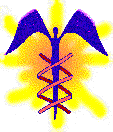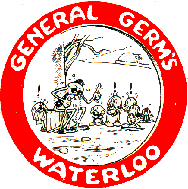

|
|
|
C O N T E N T S
Book review: A Return to Healing (click) 'Free' Care and Free Choice: Have It Both Ways (click)
Orthomolecular
Medicine Nutrigenetics and YOU (page 11) Vascular Rheology (page 12) Popeye and Scurvy (page 10) Scurvy: Cosmic Connection by I. Stone (offsite) Dr. Huemer's Secret of Bliss (page 8)
Mental
Illness and Mind-Body Problem
(page 7)
Bill
Gates' Global Health Challenge (page
9) |
Orthomolecular Medicine by Richard P. Huemer, M.D.
Original manuscript submitted September 18, 1997; published in Encyclopedia of Complementary Health Practice, edited by Carolyn C. Cook, Springer Publishing Co., NY, © 1999
Orthomolecular medicine is defined as the provision of the optimum molecular constitution, especially the optimum concentration of substances that are normally present in the body, for the purposes of treating disease and preserving health. The term was coined by Linus Pauling in his 1968 theoretical analysis of megavitamin therapy in psychiatry.
Megavitamin therapy is most closely identified with Abram Hoffer and Humphry Osmond, who in 1954 published the first double-blind controlled study in psychiatry, on the treatment of schizophrenia with nicotinic acid and nicotinamide. However, substantial doses of vitamins as therapy for medical and psychiatric conditions had been reported in the 1940s, and even earlier.
In orthomolecular medicine, diseases are assumed to originate from multiple nonspecific causes, congenital and acquired. These causes give rise to biochemical aberrations, the accumulation of which results in symptoms and signs, from which the perception of a disease state follows. Clinically-apparent diseases may be described as fuzzy sets of biochemical anomalies. Clearly, it is advantageous for physicians to recognize and to correct patients’ small sets of biochemical anomalies an early stage, before expansion of the sets results in recognizable diseases.
In practice, the orthomolecular doctor relies heavily on laboratory testing. In addition to standard clinical chemistries, orthomolecular doctors now employ a wide range of sophisticated laboratory analyses, including those for amino acids, organic acids, vitamins and minerals, functional vitamin status, hormones, immunology, microbiology, and gastrointestinal function. It is to be expected that, as the Human Genome Project progresses, orthomolecular practitioners will increasingly utilize genetic probes to assess the hereditary components of disease.
The orthomolecular model of disease complements and extends the standard medical model, rather than replacing it. As Hoffer wrote (1989): "Nor is orthomolecular treatment a replacement for standard treatment. A proportion of patients will require orthodox treatment, a proportion will do much better on orthomolecular treatment, and the rest will need a skillful blend of both."
Orthomolecular therapy consists in providing optimal amounts of substances normal to the body, by oral or parenteral administration. In the early days of orthomolecular medicine, this usually meant high-dose, single-agent nutrient therapy. However, some ailments require the withholding of normal substances; e.g., the orthomolecular amount of phenylalanine for a phenylketonuric infant approaches zero. Thus, "optimal" is a matter for clinical judgment. Most often, the orthomolecular practitioner employs multiple vital substances--amino acids, enzymes, non-essential nutrients, hormones, vitamins, minerals, etc.--in a therapeutic effort to restore those (or derivative substances) to levels statistically normal for healthy young persons.
The power of the orthomolecular approach is illustrated by its broad relevance. Hoffer in particular has outlined (1989) orthomolecular strategies for cardiovascular diseases, gastrointestinal disorders, arthritis, neurological diseases, metabolic stress, psychiatry, cancer, and dermatological disorders. Although a full understanding of the aging process remains elusive, orthomolecular medicine offers a rational way to address the multiple cellular and metabolic derangements associated with aging, especially those related to oxidative stress.
Orthomolecular medicine rests on the broad research base of the world’s scientific literature in nutrition, metabolism, endocrinology, biochemical genetics, and cell biology. Some of the more clinically relevant literature has been abstracted by Werbach (1996). Clinical studies, reviews, letters and editorials are published quarterly in Journal of Orthomolecular Medicine, edited by Hoffer.
REFERENCES
1. Hoffer, A.: Orthomolecular Medicine for Physicians. Keats Publishing, New Canaan, Connecticut, 1989.
2. Huemer, R.P.: A theory of diagnosis for orthomolecular medicine. J. Theor. Biol. 67: 625-635, 1977; reprinted in Advances 1(3): 53-59, 1984.
3. Huemer, R.P.: The Roots of Molecular Medicine: A Tribute to Linus Pauling. W. H. Freeman and Company, New York, 1986.
4. Pauling, L.: Orthomolecular psychiatry. Science 160: 265-271, 1968.
5. Werbach, M.R.: Nutritional Influences on Illness, Second Edition. Third Line Press, Tarzana, California, 1996.
|
|
General Germ meets his Waterloo when we get enough vitamin C! Learn more at links: www.orthomed.com www.vitamincfoundation.org
Drawing by RMH ©1924 by Boston Woven Hose and Rubber Co. |
|
![]()
![]()
![]()
![]()
![]()
![]()
![]()

